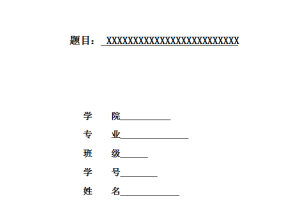Contents
Chapter I How Negotiations Work: An Overview· 7
1.2 Major Elements of Negotiation· 8
1.2.2 Power (Bargaining Strength) 10
1.3 The Cross-cultural Negotiation Process· 12
Chapter II Culture and its Impacts on Negotiations· 15
2.1.1 Definition of Culture· 15
2.1.2 Characteristics of Culture· 16
2.1.3 Cultural Orientations· 19
2.1.4. Deep Structure of Culture· 20
2.2 General Impacts of Culture on Business Negotiations· 26
2.2.1 Influences Exerted by Cultural Differences· 26
2.2.2 Consequences Caused by Cultural Differences· 27
Chapter III Sino-American Negotiating Styles: A Cross-cultural Perspective 30
3.8 Willingness to Take Risks· 51
Chapter IV Conclusion and Recommendations for Chinese Negotiators 55
4.1 Potential Problems in Intercultural Business Negotiations· 55
4.2 Recommendations for Chinese Negotiators· 58
4.2.1 Cultivating Cultural Awareness and Sensitivity· 58
4.2.2 Making sufficient preparations· 60
4.2.3 Having a Good Command of the Target Language· 60
4.2.4 Laying Great Emphasis on Non-verbal Communications· 61
Abstract
With the emergence of a global economy and China’s WTO entry, China has witnessed a sharp increase in foreign investment and numerous China-based firms into the international market. So far as Chinese businesspersons are concerned, at no time in history has there been so great a need for international negotiating skills.
Nevertheless, what makes one a good negotiator in one culture may not work well in another, because negotiation rules and practices vary notably across cultures. The greater the cultural differences, the larger barriers to communication, and the more likely distortion of the negotiation. To negotiate successfully, cultural differences between the parties concerned must be identified and bridged.
The thesis is a comparative study of the different types of Sino-American business negotiating styles. There are many factors contributing to a certain type of negotiating style, but cultural system may be one of the most important. Efforts in the thesis are devoted to exploring the underlying cultural factors behind the distinctions of these negotiating styles. The objective is to improve the knowledge and understanding of negotiation-related cultural differences and furnish some recommendations for Chinese negotiators involved in Sino-American business negotiations.
The thesis consists of four parts.
With a view to better understanding international business negotiation, Chapter one briefs the fundamental knowledge of negotiations, including its definition, its basic elements and the cross-cultural negotiation process.
To navigate through the minefield of Sino-American business negotiations requires a full apprehension of culture and its relevant factors. In Chapter two, therefore, the major elements of culture, including its concept, its characteristics, cultural orientations and its deep structure are first dealt with, and then the impact of culture on business negotiations.
The great diversity of culture makes it difficult for negotiators to fully understand the culture differences between China and America and then an approach that helps Chinese negotiators overcome the differences in making their deal is proposed to identify the specific ways in which cultural traits affect the negotiating process. Eight factors that affect negotiating styles, accordingly, are provided in Chapter Three and then by using these factors as parameters a comparative study between Chinese negotiating style and American negotiating style is made. Moreover, the underlying cultural influence is investigated.
The last Chapter points out the potential problems in cross-cultural business negotiations and then provides Chinese negotiators with some recommendations for their entering the business negotiations.
内容摘要
随着经济全球化的出现和中国加入世界贸易组织, 国外在华投资急剧增多,与此同时,大批中国企业也开始走向国际市场。在这样的历史条件下,中国商人对国际谈判技能的渴求也空前强烈,然而,由于谈判规则和惯例在文化间存在着较大差异,在一种文化中驾轻就熟的谈判者在另一种文化中可能就无大的建树。事实上,文化差异越大,交流的障碍也就越大,也就越可能影响谈判的效果。因此,谈判的成功需要谈判双方明确其中的文化差异并着手加以沟通。
本文旨在对中美商务谈判风格的差异进行对比研究。一种谈判风格的形成可能源于多种因素,毫无疑问,文化是其中最重要的一个方面。本文从跨文化的角度来探讨两种谈判风格差异背后的文化因素。通过对影响谈判的文化差异因素的深刻理解,作者试图为参与中美商务谈判的中国谈判者提出自己的一些建议。
本文共四部分:
为了对国际商务谈判有较好的理解,第一章简要介绍了谈判的基本知识:谈判的定义,谈判的基本要素和跨文化谈判的过程。
要顺利跨越中美商务谈判中可能出现的“雷区”,就需要对文化及其相关因素有一个全面的了解。为此,文章第二部分论述了文化的重要因素,这包括文化的概念和特征,文化取向和其深层结构以及文化对商务谈判的影响。
文化的多样性使得谈判者很难对中美文化有着全面而详尽的理解,一种有助于谈判者克服文化差异从而达成交易的方法是明确文化影响谈判过程的具体方面。为此,文章第三部分提出了影响谈判风格的八种因素并以此为参照物对中美谈判风格进行对比研究。同时也对影响这些因素的深层文化背景进行了探讨。
本文第四章指出了跨文化商务谈判中的潜在问题并为从事商务谈判的中国谈判者提供了一些建议。





